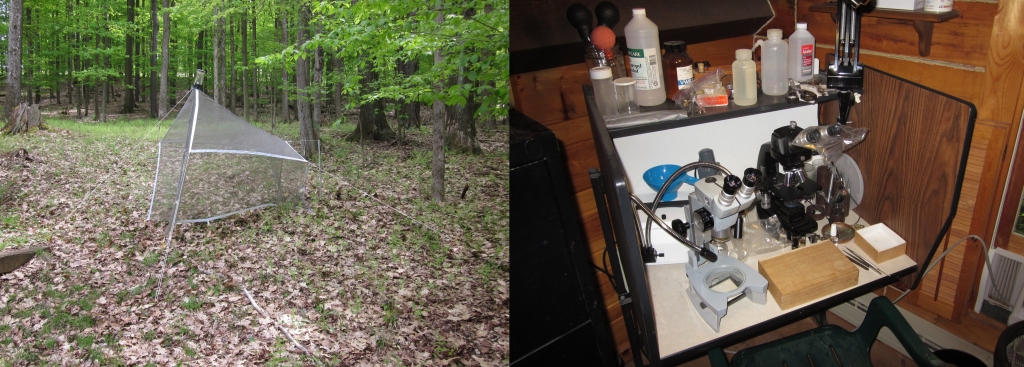More Literature
May 13, 2013I added nine literature citations to the Bibliography. This nine is a miscellany; only two--Franklin (1912) and Free and Butler (1959)--directly mention North American Laphriini in North America, and the latter is a citation and not an original observation. The full citations for these two references are:
Franklin, H. J. 1912. The Bombidae of the New World. Trans. Amer. Entomol. Soc. 39:177-486 (pp. 238, Dasyllis thoracica Fabricius, D. affinis Macquart, D. tergissa (var.), and D. flavicollis Say all resemble Bombus impatiens and Psithyrus laboriosus, and all are found within the ranges of these two bee species; Dasyllis sacrator Walker resembles Bombus vagans and B. perplexus and is found within the ranges of these two bee species in the northeastern United States and southeastern Canada; Dasyllis astur O. S. resembles Bombus californiens and B. vosnesenskii and it ranges with those species in the Pacific Coast States; last, Dasyllis posticata Say resembles Bombus fervidus females and both are distributed widely; pp. 237-239; discusses Batesian and aggressive mimicry of bumble bees by robber flies and syrphids.).
Free, J. B. and G. C. Butler. 1959. Bumble Bees. Collins, St. James Place, London. (The New Naturalist series; pp. 81-82, Dasyllis grossa).
Three--Wichmann (1956), Perris (1871), and Quentin (1948)--mention the Holarctic species Choerades gilvus in Europe or Asia. These references are to morphology or biology--I do not currently plan to include references to Palaearctic distribution records of C. gilvus here. I can't see that these would add anything to a review of the North American species, which is what this website is about; and their inclusion would dilute the ratio of useful information to noise. The biological material, though, is germane, as it changes the status of C. gilvus in North America from being one of the more obscure species, to being one of the best studied overall. I am certain I have not exhausted a listing of these biological references, and will undoubtedly have more to add later. The three current references on Palaearctic Choerades gilvus are:
Wichmann, H. E. 1956. Untersuchungen uber Ips typographus L. und seine Umwelt-Asilidae, Raubfliegen. Zeit. Angewandte Entomol. 39:58-62 (Description of egg of Laphria gilva L.).
Perris, E. 1871. Histoire des insectes du Pin Maritime. Dipteres. Ann. Soc. Ent. France, ser. 4, 10:135-232, 320-366, pls. 1-5 (pp. 212-221, pl. 3, figs. 89-86.) (Development of Laphria gilva).
Quentin, R. M. 1948. Sur la nymphe de Laphria gilva L. (Dipt. Asilidae). Entomologiste 4:9-10 (Describes pupa of Laphria gilva).
I also included a description of the female terminalia of a Japanese species of Laphria--Nagatomi and Nagatomi (1989). The article is very well done. The pair had appently not seen my 1986 dissertation. The full citation is:
Nagatomi, H., and A. Nagatomi. 1989. Female terminalia of Goneccalypsis lucida and Laphria nigrovittata (Diptera, Asilidae). South Pacific Study 9(1-2):1-10 (title is self explanatory; Laphria nigrovitta is a Japanese species. The article is included here because it is the only detailed description of female terminalia of Laphria other than those in my dissertation; this one includes all the various setae as well, which I omitted in mine to facilitate comparisons in overall structure between species. Off-site PDF can be found here.).
Next, there are two references--Krivoshenia and Mamaev (1975a) and Krivoshenia and Mamaev (1975b)--that probably will contain much that is of interest for North American workers, although it is likely neither mentions any North American species. Both are in Russian. One deals with the larvae of Choerades, the other with the larvae of Laphria. I haven't read translations of either. They are:
Krivoshenia, N. P. and B. M. Mamaev. 1975a. Revision of data on the morphology and ecology of xylophile larvae of Laphriini (Dipt., Asilidae). I. Genus Choerades Walk. vestn. Zool. 2:66-77 (In Russian).
Krivoshenia, N. P. and B. M. Mamaev. 1975b. Revision of materials on the morphology and eclogy of xylophilic assassin fly larvae of the tribe Laphriini (Diptera, Asilidae): II. Genus Laphria, Mg. Vestn. Zool. 6:46-50 (In Russian).
Last, I included one reference--Londt (1977)--only because it refers to the Laphriini as a whole, and includes the description of two new genera from Southern Africa. I thought this would be of use because I will eventually be publishing the descriptions of the two new genera I described in my dissertation, and they are obviously different from the two described in this paper (it is well illustrated). That reference is:
Londt, J. G. H. 1977. Afrotropical Asilidae (Diptera) 1. The genus Choerades Walker, 1851, and the descriptions of two new genera, Nannolaphria and Notiolaphria, from southern Africa and Malagasy Republic. Ann. Natal Mus. 23(1):43-55. (nothing directly on Nearctic Laphriini; the new genera, however, are in the tribe).


 Digg
Digg
 Facebook
Facebook
 StumbleUpon
StumbleUpon
 LinkedIn
LinkedIn
 Twitter
Twitter
 Email
Email